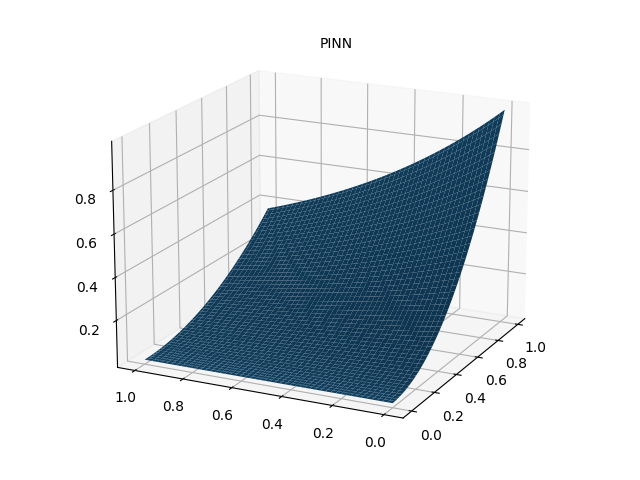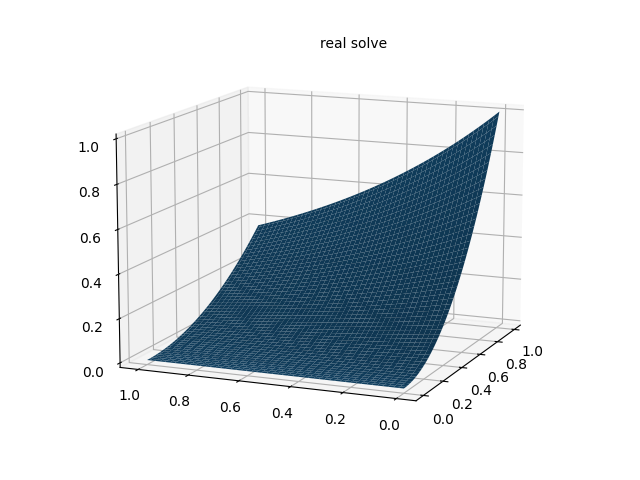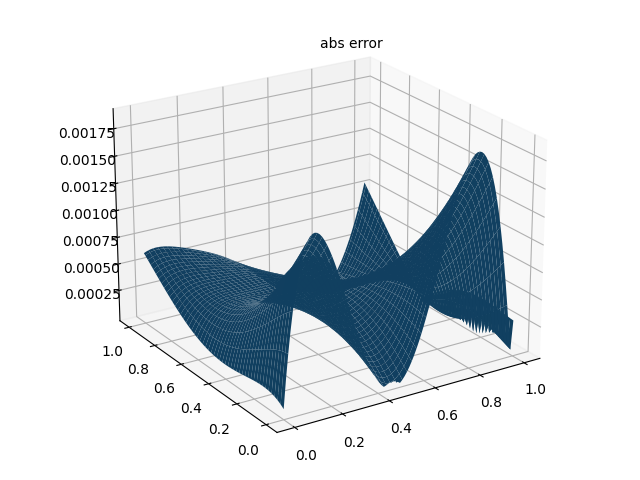pinn解偏微分方程实例1
更新:
最近使用下面代码框架求解了三个具体的偏微分方程,主要是对结果进行了可视化展示(一些漂亮的结果图),包括diffusion,burgers和allen–cahn方程;另外以burgers 方程为例,对解 pde 反问题的结果也进行了可视化展示,具体见pinn解偏微分方程实例5.
更新:
最近使用下面代码框架求解了四个具体的偏微分方程,包括diffusion,burgers, allen–cahn和wave方程,另外重新写了一个 求解反问题的代码框架,以burgers 方程为例,具体见pinn解偏微分方程实例4.
1. pinn简介
pinn是一种利用神经网络求解偏微分方程的方法,其计算流程图如下图所示,这里以偏微分方程(1)为例。
∂
u
∂
t
+
u
∂
u
∂
x
=
v
∂
2
u
∂
x
2
\begin{align} \frac{\partial u}{\partial t}+u \frac{\partial u}{\partial x}=v\frac{\partial^2 u}{\partial x^2} \end{align}
∂t∂u+u∂x∂u=v∂x2∂2u
神经网络输入位置x,y,z和时间t的值,预测偏微分方程解u在这个时空条件下的数值解。

上图中可以看出,pinn的损失函数包含两部分内容,一部分是来源于训练数据误差,另一部分来源于偏微分方程误差,可以记作(2)式。
l
=
w
d
a
t
a
l
d
a
t
a
+
w
p
d
e
l
p
d
e
\begin{align} \mathcal{l} = w_{data}\mathcal{l}_{data}+w_{pde}\mathcal{l}_{pde} \end{align}
l=wdataldata+wpdelpde
其中
l
d
a
t
a
=
1
n
d
a
t
a
∑
i
=
1
n
d
a
t
a
(
u
(
x
i
,
t
i
)
−
u
i
)
2
l
p
d
e
=
1
n
d
a
t
a
∑
j
=
1
n
p
d
e
(
∂
u
∂
t
+
u
∂
u
∂
x
−
v
∂
2
u
∂
x
2
)
2
∣
(
x
j
,
t
j
)
\begin{align} \begin{aligned} \mathcal{l}_{data} &= \frac{1}{n_{data}}\sum_{i=1}^{n_{data}} (u(x_i,t_i)-u_i)^2 \\ \mathcal{l}_{pde} &= \frac{1}{n_{data}}\sum_{j=1}^{n_{pde}} \left( \frac{\partial u}{\partial t}+u \frac{\partial u}{\partial x}-v\frac{\partial^2 u}{\partial x^2} \right)^2|_{(x_j,t_j)} \end{aligned} \end{align}
ldatalpde=ndata1i=1∑ndata(u(xi,ti)−ui)2=ndata1j=1∑npde(∂t∂u+u∂x∂u−v∂x2∂2u)2∣(xj,tj)
2. 偏微分方程实例
考虑偏微分方程如下:
∂
2
u
∂
x
2
−
∂
4
u
∂
y
4
=
(
2
−
x
2
)
e
−
y
\begin{align} \begin{aligned} \frac{\partial^2 u}{\partial x^2} - \frac{\partial^4 u}{\partial y^4} = (2-x^2)e^{-y} \end{aligned} \end{align}
∂x2∂2u−∂y4∂4u=(2−x2)e−y
考虑以下边界条件,
u
y
y
(
x
,
0
)
=
x
2
u
y
y
(
x
,
1
)
=
x
2
e
u
(
x
,
0
)
=
x
2
u
(
x
,
1
)
=
x
2
e
u
(
0
,
y
)
=
0
u
(
1
,
y
)
=
e
−
y
\begin{align} \begin{aligned} u_{yy}(x,0) &= x^2 \\ u_{yy}(x,1) &= \frac{x^2}{e} \\ u(x,0) &= x^2 \\ u(x,1) &= \frac{x^2}{e} \\ u(0,y) &= 0 \\ u(1,y) &= e^{-y} \\ \end{aligned} \end{align}
uyy(x,0)uyy(x,1)u(x,0)u(x,1)u(0,y)u(1,y)=x2=ex2=x2=ex2=0=e−y
以上偏微分方程真解为
u
(
x
,
y
)
=
x
2
e
−
y
u(x,y)=x^2 e^{-y}
u(x,y)=x2e−y,在区域
[
0
,
1
]
×
[
0
,
1
]
[0,1]\times[0,1]
[0,1]×[0,1]上随机采样配置点和数据点,其中配置点用来构造pde损失函数
l
1
,
l
2
,
⋯
,
l
7
\mathcal{l}_1,\mathcal{l}_2,\cdots,\mathcal{l}_7
l1,l2,⋯,l7,数据点用来构造数据损失函数
l
8
\mathcal{l}_8
l8.
l
1
=
1
n
1
∑
(
x
i
,
y
i
)
∈
ω
(
u
^
x
x
(
x
i
,
y
i
;
θ
)
−
u
^
y
y
y
y
(
x
i
,
y
i
;
θ
)
−
(
2
−
x
i
2
)
e
−
y
i
)
2
l
2
=
1
n
2
∑
(
x
i
,
y
i
)
∈
[
0
,
1
]
×
{
0
}
(
u
^
y
y
(
x
i
,
y
i
;
θ
)
−
x
i
2
)
2
l
3
=
1
n
3
∑
(
x
i
,
y
i
)
∈
[
0
,
1
]
×
{
1
}
(
u
^
y
y
(
x
i
,
y
i
;
θ
)
−
x
i
2
e
)
2
l
4
=
1
n
4
∑
(
x
i
,
y
i
)
∈
[
0
,
1
]
×
{
0
}
(
u
^
(
x
i
,
y
i
;
θ
)
−
x
i
2
)
2
l
5
=
1
n
5
∑
(
x
i
,
y
i
)
∈
[
0
,
1
]
×
{
1
}
(
u
^
(
x
i
,
y
i
;
θ
)
−
x
i
2
e
)
2
l
6
=
1
n
6
∑
(
x
i
,
y
i
)
∈
{
0
}
×
[
0
,
1
]
(
u
^
(
x
i
,
y
i
;
θ
)
−
0
)
2
l
7
=
1
n
7
∑
(
x
i
,
y
i
)
∈
{
1
}
×
[
0
,
1
]
(
u
^
(
x
i
,
y
i
;
θ
)
−
e
−
y
i
)
2
l
8
=
1
n
8
∑
i
=
1
n
8
(
u
^
(
x
i
,
y
i
;
θ
)
−
u
i
)
2
\begin{align} \begin{aligned} \mathcal{l}_1 &= \frac{1}{n_1}\sum_{(x_i,y_i)\in\omega} (\hat{u}_{xx}(x_i,y_i;\theta) - \hat{u}_{yyyy}(x_i,y_i;\theta) - (2-x_i^2)e^{-y_i})^2 \\ \mathcal{l}_2 &= \frac{1}{n_2}\sum_{(x_i,y_i)\in[0,1]\times\{0\}} (\hat{u}_{yy}(x_i,y_i;\theta) - x_i^2)^2 \\ \mathcal{l}_3 &= \frac{1}{n_3}\sum_{(x_i,y_i)\in[0,1]\times\{1\}} (\hat{u}_{yy}(x_i,y_i;\theta) - \frac{x_i^2}{e})^2 \\ \mathcal{l}_4 &= \frac{1}{n_4}\sum_{(x_i,y_i)\in[0,1]\times\{0\}} (\hat{u}(x_i,y_i;\theta) - x_i^2)^2 \\ \mathcal{l}_5 &= \frac{1}{n_5}\sum_{(x_i,y_i)\in[0,1]\times\{1\}} (\hat{u}(x_i,y_i;\theta) - \frac{x_i^2}{e})^2 \\ \mathcal{l}_6 &= \frac{1}{n_6}\sum_{(x_i,y_i)\in\{0\}\times [0,1]}(\hat{u}(x_i,y_i;\theta) - 0)^2 \\ \mathcal{l}_7 &= \frac{1}{n_7}\sum_{(x_i,y_i)\in\{1\}\times [0,1]}(\hat{u}(x_i,y_i;\theta) - e^{-y_i})^2 \\ \mathcal{l}_8 &= \frac{1}{n_{8}}\sum_{i=1}^{n_{8}} (\hat{u}(x_i,y_i;\theta)-u_i)^2 \end{aligned} \end{align}
l1l2l3l4l5l6l7l8=n11(xi,yi)∈ω∑(u^xx(xi,yi;θ)−u^yyyy(xi,yi;θ)−(2−xi2)e−yi)2=n21(xi,yi)∈[0,1]×{0}∑(u^yy(xi,yi;θ)−xi2)2=n31(xi,yi)∈[0,1]×{1}∑(u^yy(xi,yi;θ)−exi2)2=n41(xi,yi)∈[0,1]×{0}∑(u^(xi,yi;θ)−xi2)2=n51(xi,yi)∈[0,1]×{1}∑(u^(xi,yi;θ)−exi2)2=n61(xi,yi)∈{0}×[0,1]∑(u^(xi,yi;θ)−0)2=n71(xi,yi)∈{1}×[0,1]∑(u^(xi,yi;θ)−e−yi)2=n81i=1∑n8(u^(xi,yi;θ)−ui)2
3. 基于pytorch实现代码
"""
a scratch for pinn solving the following pde
u_xx-u_yyyy=(2-x^2)*exp(-y)
author: st
date: 2023/2/26
"""
import torch
import matplotlib.pyplot as plt
from mpl_toolkits.mplot3d import axes3d
epochs = 10000 # 训练代数
h = 100 # 画图网格密度
n = 1000 # 内点配置点数
n1 = 100 # 边界点配置点数
n2 = 1000 # pde数据点
def setup_seed(seed):
torch.manual_seed(seed)
torch.cuda.manual_seed_all(seed)
torch.backends.cudnn.deterministic = true
# 设置随机数种子
setup_seed(888888)
# domain and sampling
def interior(n=n):
# 内点
x = torch.rand(n, 1)
y = torch.rand(n, 1)
cond = (2 - x ** 2) * torch.exp(-y)
return x.requires_grad_(true), y.requires_grad_(true), cond
def down_yy(n=n1):
# 边界 u_yy(x,0)=x^2
x = torch.rand(n, 1)
y = torch.zeros_like(x)
cond = x ** 2
return x.requires_grad_(true), y.requires_grad_(true), cond
def up_yy(n=n1):
# 边界 u_yy(x,1)=x^2/e
x = torch.rand(n, 1)
y = torch.ones_like(x)
cond = x ** 2 / torch.e
return x.requires_grad_(true), y.requires_grad_(true), cond
def down(n=n1):
# 边界 u(x,0)=x^2
x = torch.rand(n, 1)
y = torch.zeros_like(x)
cond = x ** 2
return x.requires_grad_(true), y.requires_grad_(true), cond
def up(n=n1):
# 边界 u(x,1)=x^2/e
x = torch.rand(n, 1)
y = torch.ones_like(x)
cond = x ** 2 / torch.e
return x.requires_grad_(true), y.requires_grad_(true), cond
def left(n=n1):
# 边界 u(0,y)=0
y = torch.rand(n, 1)
x = torch.zeros_like(y)
cond = torch.zeros_like(x)
return x.requires_grad_(true), y.requires_grad_(true), cond
def right(n=n1):
# 边界 u(1,y)=e^(-y)
y = torch.rand(n, 1)
x = torch.ones_like(y)
cond = torch.exp(-y)
return x.requires_grad_(true), y.requires_grad_(true), cond
def data_interior(n=n2):
# 内点
x = torch.rand(n, 1)
y = torch.rand(n, 1)
cond = (x ** 2) * torch.exp(-y)
return x.requires_grad_(true), y.requires_grad_(true), cond
# neural network
class mlp(torch.nn.module):
def __init__(self):
super(mlp, self).__init__()
self.net = torch.nn.sequential(
torch.nn.linear(2, 32),
torch.nn.tanh(),
torch.nn.linear(32, 32),
torch.nn.tanh(),
torch.nn.linear(32, 32),
torch.nn.tanh(),
torch.nn.linear(32, 32),
torch.nn.tanh(),
torch.nn.linear(32, 1)
)
def forward(self, x):
return self.net(x)
# loss
loss = torch.nn.mseloss()
def gradients(u, x, order=1):
if order == 1:
return torch.autograd.grad(u, x, grad_outputs=torch.ones_like(u),
create_graph=true,
only_inputs=true, )[0]
else:
return gradients(gradients(u, x), x, order=order - 1)
# 以下7个损失是pde损失
def l_interior(u):
# 损失函数l1
x, y, cond = interior()
uxy = u(torch.cat([x, y], dim=1))
return loss(gradients(uxy, x, 2) - gradients(uxy, y, 4), cond)
def l_down_yy(u):
# 损失函数l2
x, y, cond = down_yy()
uxy = u(torch.cat([x, y], dim=1))
return loss(gradients(uxy, y, 2), cond)
def l_up_yy(u):
# 损失函数l3
x, y, cond = up_yy()
uxy = u(torch.cat([x, y], dim=1))
return loss(gradients(uxy, y, 2), cond)
def l_down(u):
# 损失函数l4
x, y, cond = down()
uxy = u(torch.cat([x, y], dim=1))
return loss(uxy, cond)
def l_up(u):
# 损失函数l5
x, y, cond = up()
uxy = u(torch.cat([x, y], dim=1))
return loss(uxy, cond)
def l_left(u):
# 损失函数l6
x, y, cond = left()
uxy = u(torch.cat([x, y], dim=1))
return loss(uxy, cond)
def l_right(u):
# 损失函数l7
x, y, cond = right()
uxy = u(torch.cat([x, y], dim=1))
return loss(uxy, cond)
# 构造数据损失
def l_data(u):
# 损失函数l8
x, y, cond = data_interior()
uxy = u(torch.cat([x, y], dim=1))
return loss(uxy, cond)
# training
u = mlp()
opt = torch.optim.adam(params=u.parameters())
for i in range(epochs):
opt.zero_grad()
l = l_interior(u) \
+ l_up_yy(u) \
+ l_down_yy(u) \
+ l_up(u) \
+ l_down(u) \
+ l_left(u) \
+ l_right(u) \
+ l_data(u)
l.backward()
opt.step()
if i % 100 == 0:
print(i)
# inference
xc = torch.linspace(0, 1, h)
xm, ym = torch.meshgrid(xc, xc)
xx = xm.reshape(-1, 1)
yy = ym.reshape(-1, 1)
xy = torch.cat([xx, yy], dim=1)
u_pred = u(xy)
u_real = xx * xx * torch.exp(-yy)
u_error = torch.abs(u_pred-u_real)
u_pred_fig = u_pred.reshape(h,h)
u_real_fig = u_real.reshape(h,h)
u_error_fig = u_error.reshape(h,h)
print("max abs error is: ", float(torch.max(torch.abs(u_pred - xx * xx * torch.exp(-yy)))))
# 仅有pde损失 max abs error: 0.004852950572967529
# 带有数据点损失 max abs error: 0.0018916130065917969
# 作pinn数值解图
fig = plt.figure()
ax = axes3d(fig)
ax.plot_surface(xm.detach().numpy(), ym.detach().numpy(), u_pred_fig.detach().numpy())
ax.text2d(0.5, 0.9, "pinn", transform=ax.transaxes)
plt.show()
fig.savefig("pinn solve.png")
# 作真解图
fig = plt.figure()
ax = axes3d(fig)
ax.plot_surface(xm.detach().numpy(), ym.detach().numpy(), u_real_fig.detach().numpy())
ax.text2d(0.5, 0.9, "real solve", transform=ax.transaxes)
plt.show()
fig.savefig("real solve.png")
# 误差图
fig = plt.figure()
ax = axes3d(fig)
ax.plot_surface(xm.detach().numpy(), ym.detach().numpy(), u_error_fig.detach().numpy())
ax.text2d(0.5, 0.9, "abs error", transform=ax.transaxes)
plt.show()
fig.savefig("abs error.png")
4. 数值解






发表评论